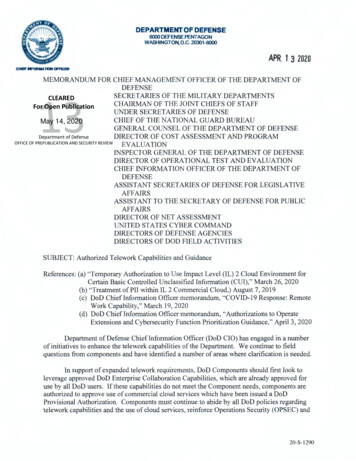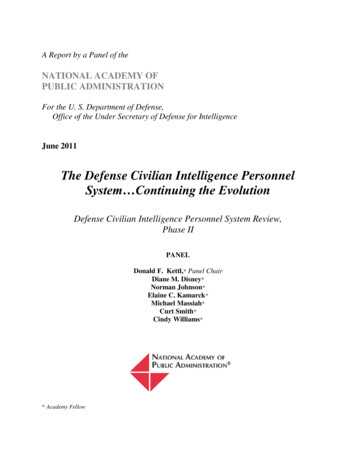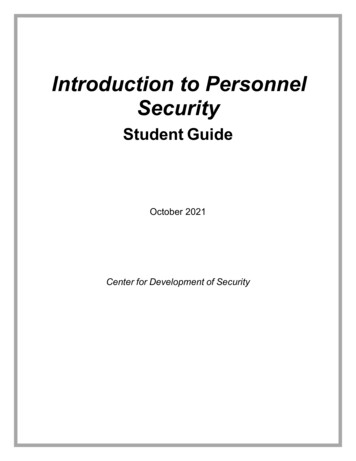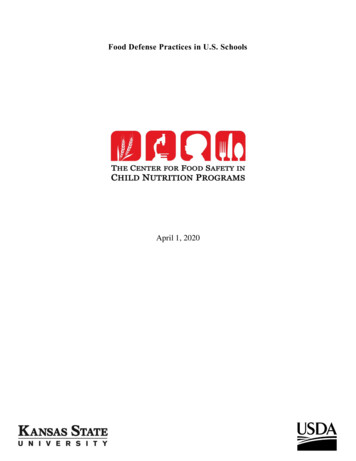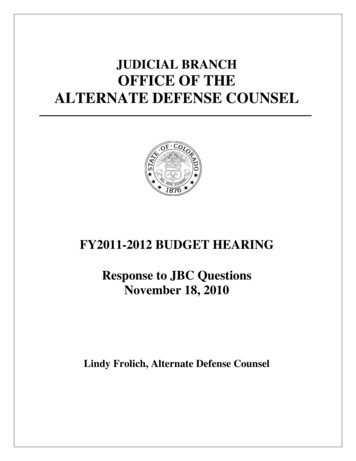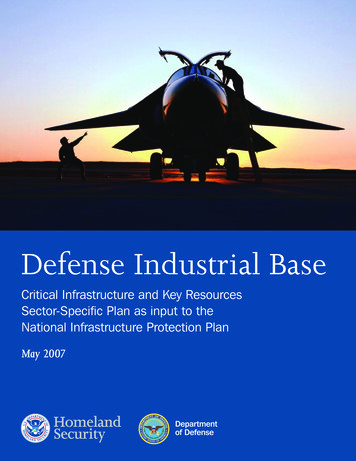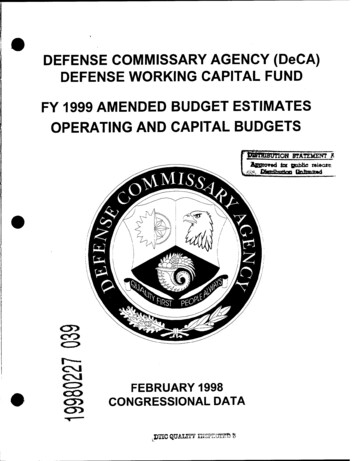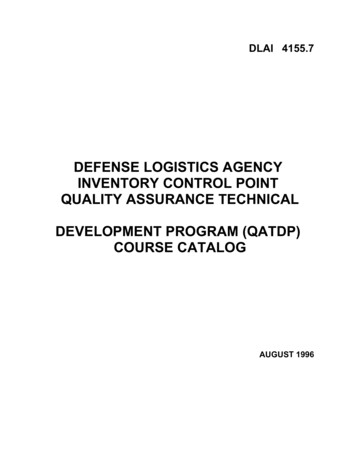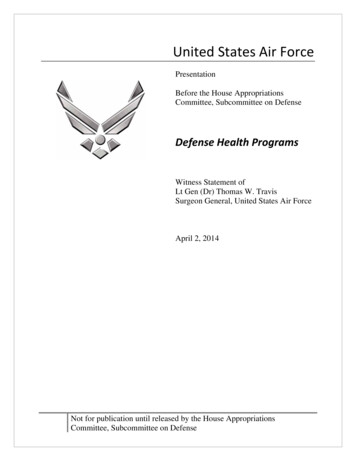
Transcription
United States Air ForcePresentationBefore the House AppropriationsCommittee, Subcommittee on DefenseDefense Health ProgramsWitness Statement ofLt Gen (Dr) Thomas W. TravisSurgeon General, United States Air ForceApril 2, 2014Not for publication until released by the House AppropriationsCommittee, Subcommittee on Defense
Defense Health ProgramsApril 2, 2014UNITED STATES AIR FORCELIEUTENANT GENERAL (DR.) THOMAS W. TRAVISLt. Gen. (Dr.) Thomas W. Travis is the SurgeonGeneral of the Air Force, Headquarters U.S. AirForce, Washington, D.C. General Travis serves asfunctional manager of the U.S. Air Force MedicalService. In this capacity, he advises the Secretary ofthe Air Force and Air Force Chief of Staff, as well asthe Assistant Secretary of Defense for Health Affairson matters pertaining to the medical aspects of theair expeditionary force and the health of Air Forcepeople. General Travis has authority to commitresources worldwide for the Air Force MedicalService, to make decisions affecting the delivery ofmedical services, and to develop plans, programsand procedures to support worldwide medical servicemissions. He exercises direction, guidance andtechnical management of more than 42,800 peopleassigned to 75 medical facilities worldwide.General Travis entered the Air Force in 1976 as adistinguished graduate of the ROTC program atVirginia Polytechnic Institute and State University. Hewas awarded his pilot wings in 1978 and served as an F-4 pilot and aircraft commander. The general completedhis medical degree from the Uniformed Services University of the Health Sciences School of Medicine, wherehe was the top Air Force graduate, and in 1987 he became a flight surgeon. For more than three years, GeneralTravis was Chief of Medical Operations for the Human Systems Program Office at Brooks Air Force Base,Texas. He later served as the Director of Operational Health Support and Chief of Aerospace Medicine Divisionfor the Air Force Medical Operations Agency in Washington, D.C.Prior to his current assignment, Gen Travis served as Deputy Surgeon General, Headquarters U.S. Air Force,Washington, D.C. The general has commanded the U.S. Air Force School of Aerospace Medicine; 311thHuman Systems Wing at Brooks AFB; Malcolm Grow Medical Center and 79th Medical Wing, Andrews AFB,Md.; and the 59th Medical Wing, Wilford Hall Medical Center, Lackland AFB, Texas. He also served as theCommand Surgeon, Headquarters Air Force District of Washington, and Command Surgeon, Headquarters AirCombat Command, Langley AFB, Va. He is board certified in aerospace medicine. A command pilot and chiefPage 2
Defense Health ProgramsApril 2, 2014flight surgeon, he has more than 1,800 flying hours and is one of the Air Force's few pilot-physicians. He hasflown the F-4, F-15 and F-16 as mission pilot and, the Royal Air Force Hawk as the senior medical officer andpilot.EDUCATION1976 Distinguished graduate, Bachelor of Science degree in biology, Virginia Polytechnic Institute and StateUniversity, Blacksburg1980 Master of Science degree in physiology, Virginia Polytechnic Institute and State University, Blacksburg1986 Doctor of Medicine degree, Uniformed Services University of the Health Sciences School of Medicine,Bethesda, Md.1991 Master of Science degree in public health, University of Texas Health Science Center, San Antonio, Texas1996 Air War College, by correspondence1999 Distinguished graduate, Master of Science degree in national resource strategy, Industrial College of theArmed Forces, Fort Lesley J. McNair, Washington, D.C.2000 Medical Capstone, Walter Reed Army Medical Center, Washington, D.C.2003 Federal Health Care Executive Course, Interagency Institute, George Washington U., Washington, D.C.2005 Capstone, Fort Lesley J. McNair, Washington, D.CASSIGNMENTS1. April 1977 - March 1978, student, undergraduate pilot training, Williams AFB, Ariz.2. May 1978 - August 1978, student, fighter lead-in training, Holloman AFB, N.M.3. August 1978 - February 1979, student, F-4 Replacement Training Unit, MacDill AFB, Fla.4. February 1979 - June 1982, F-4 aircraft commander, 334th Tactical Fighter Squadron, Seymour Johnson AirForce Base, N.C.5. August 1982 - May 1986, medical student, Uniformed Services University of the Health Sciences School ofMedicine, Bethesda, Md.6. July 1986 - June 1987, internship, Andrews AFB, Md.7. July 1987 - July 1990, F-15 pilot physician, Langley AFB, Va.8. August 1990 - June 1992, resident in aerospace medicine, Brooks AFB, Texas9. July 1992 - April 1996, Chief, Medical Operations, Human Systems Program Office, Brooks AFB, Texas10. April 1996 - June 1998, senior medical officer pilot, Royal Air Force School of Aviation Medicine,Farnborough, England11. July 1998 - June 1999, student, National Defense University, Industrial College of the Armed Forces,National Defense University, Fort Lesley J. McNair, Washington, D.C.12. July 1999 - July 2001, Director, Operational Health Support, and Chief, Aerospace Medicine Division, AirForce Medical Operations Agency, Washington, D.C.13. July 2001 - February 2003, Commander, U.S. Air Force School of Aerospace Medicine, Brooks AFB, Texas14. February 2003 - September 2005, Commander, 311th Human Systems Wing, Brooks City-Base, Texas15. September 2005 - May 2006, Commander, 89th Medical Group, Andrews AFB, Md.16. May 2006 - August 2006, Command Surgeon, Headquarters Air Force District of Washington, Bolling AFB,D.C., and Commander, 79th Medical Wing, Andrews AFB, Md.17. September 2006 - August 2007, Command Surgeon, HQ Air Combat Command, Langley AFB, Va.18. August 2007 - November 2010, Commander, 59th Medical Wing, Lackland AFB, Texas19. November 2010 - July 2012, Deputy Surgeon General, Office of the Surgeon General, Headquarters U.S.Air Force, Washington, D.C.20. July 2012 - present, Surgeon General, Office of the Surgeon General, Headquarters U.S. Air Force,Washington, D.C.Page 3
Defense Health ProgramsApril 2, 2014FLIGHT INFORMATIONRating: Command pilot and chief flight surgeonHours: More than 1,800Aircraft flown: F-4, F-15, F-16 and Royal Air Force HawkMAJOR AWARDS AND DECORATIONSDistinguished Service MedalLegion of Merit with oak leaf clusterMeritorious Service Medal with four oak leaf clustersAerial Achievement MedalAir Force Commendation MedalJoint Service Achievement MedalCombat Readiness MedalAir Force Recognition RibbonOTHER ACHIEVEMENTS1994 Julian E. Ward Memorial Award, Aerospace Medical Association1994 Unger Literary Award, Society of U.S. Air Force Flight Surgeons1995 Paul W. Myers Award for outstanding contributions to Air Force medicine, Air Force Association2003 Stewart Lecturer, Royal Aeronautical Society2007 Marie Marvingt Award, French Society of Aerospace Medicine2007 George E. Schafer Award, Society of USAF Flight Surgeons2008 John D. Chase Award for Physician Executive Excellence, Association of Military Surgeons of the UnitedStatesPROFESSIONAL MEMBERSHIPS AND ASSOCIATIONSAcademician, International Academy of Aviation and Space MedicineMember and former President, Society of U.S. Air Force Flight SurgeonsMember and former President, International Association of Military Flight Surgeon PilotsFellow, Aerospace Medical AssociationFellow and former Aerospace Medicine Regent, American College of Preventive MedicineLife member, Association of Military Surgeons of the United StatesOrder of the DaedaliansAlpha Omega Alpha Honor Medical SocietyEFFECTIVE DATES OF PROMOTIONSecond Lieutenant June 2, 1976First Lieutenant Dec. 2, 1978Captain Feb. 25, 1982Major Feb. 25, 1988Lieutenant Colonel Feb. 25, 1994Colonel May 31, 1998Brigadier General Sept. 1, 2004Major General June 2, 2007Lieutenant General July 13, 2012(Current as of July 2012)Page 4
Defense Health ProgramsApril 2, 2014Chairman Frelinghuysen, Ranking Member Visclosky, and distinguished members of theSubcommittee, thank you for inviting me to appear before you today. The Military HealthSystem (MHS) is a world-class health care organization, and the Air Force Medical Service isproud to be a full partner. We have successfully overcome many significant challenges since welast met with the Subcommittee, and greatly appreciate your strong support.As the war draws down and the focus shifts to in-garrison care, it is tempting to comparethe MHS to civilian health care organizations. But there is a cost associated with being preparedto execute our readiness missions, and no civilian healthcare system in the world can do what wedo – and have done -- when called upon to provide deployed and en-route care. That is the onekey message I hope to leave with you today. The AFMS remains closely linked with our Armyand Navy colleagues in our efforts to achieve the MHS Quadruple Aim of Readiness, BetterHealth, Better Care, and Best Value – but Readiness is first!The AFMS is committed to supporting the Line of the Air Force mission -- our “TrueNorth” -- maintaining a medical force that is trained and ready to deploy at a moment’s notice,but also aligned with our wings in support of their operational missions. We have logged anastounding 194,300 patient movements since 9/11, including transporting 7,900 critical carepatients. We provided “care in the air” to more than 5,000 patients in 2013 alone, includingalmost 300 Critical Care Air Transport Team (CCATT) missions for the most seriously ill andinjured. Recently, the Lung Team and one of our CCATTs transported the wife of a servicemember in need of a lung transplant on an Extracorporeal Life Support (ECLS) machine fromLandstuhl, Germany to Joint Base Andrews, Maryland – the longest trip ever for transporting acritically-ill patient on ECLS who survived. Further research into use of the ECLS for thecomprehensive treatment of combat casualties with single and multi-organ failure is underway atPage 5
Defense Health ProgramsApril 2, 2014the Joint Battlefield Health and Trauma Institute by Air Force investigators. Our CCATTcapability has allowed us to advance our practice of transporting only stable patients to aparadigm of en-route patient treatment that has become integral to health service support in jointdoctrine.As we strive for even greater survival rates, we’ve evolved our CCATT capability pointof-injury response. This provides more capable care further forward and more sophisticated intransit support. Our Tactical Critical Care Evacuation Teams (TCCETs) provide damage controlresuscitation on rotary-wing, forward-deployed fixed-wing, and tilt-wing aircraft, and haveaccomplished more than 1,600 critical care patient movements since we began the program inJune 2011, many from point of injury. In an effort to ensure these teams are fully trained toprovide continuous en-route critical care, we have partnered with the University of Cincinnati(UC) Medical Center to develop a TCCET course at the same location as our CCATT training.We have dedicated Air Force Medics on staff at UC to provide this training. We have similartrauma training partnerships with Baltimore Shock Trauma and St. Louis University for ourground-based expeditionary medical teams. These partner universities are each a Center for theSustainment of Trauma and Readiness Skills, or C-STARS.Our health response teams include rapidly deployable, modular, and scalable fieldhospitals that provide immediate care within minutes of arrival. The Expeditionary MedicalSupport Health Response Teams (EMEDS HRT) are successfully deployed as a part of ourcontinuous evolution in medical response capabilities anywhere in the world. They provideimmediate emergency care within minutes to hours of arrival -- surgery and intensive criticalcare units in place within six hours, and full capability established within 12 hours of deploymentarrival.Page 6
Defense Health ProgramsApril 2, 2014The training course at Camp Bullis, near San Antonio, was updated to provide morerealistic training scenarios to prepare for disaster and humanitarian missions that may requirepediatric, women's health, and geriatric care while maintaining the ability to use this capability ina wartime setting. This evolved expeditionary HRT capability was successfully demonstrated inPeru in 2012, and is on track to be fully deployed as a replacement of our previous generation ofEMEDS by 2016.The success of TCCET, CCAT, and EMEDS-HRT in expanding our capabilities relies oncollaboration with our civilian partners in the areas of research, education and training, andprovider currency. We are involved in some amazing state-of-the-art research in our majorthrust areas of En Route Care, Force Health Protection, Expeditionary Medicine, HumanPerformance and Operational Medicine.One fascinating example is the Airborne Laser Sensor project, a collaborative effort withU.S. Customs and Border Protection that uses an AF-developed airborne sensor flown on AirForce aircraft to sense and detect laser illumination of aircrew to determine the occupationalhealth hazard from laser exposure. Another example is our partnership with the BattlefieldHealth and Trauma Research Institute and the San Antonio University Health System to conductresearch on spinal fractures, blood transfusions, sepsis, burns, hemorrhagic shock, andcompartment syndrome. In support of Human Performance and Enroute Care, our C-STARSfaculty and civilian partners are studying the timing of aeromedical evacuation on the clinicalstatus of combat casualties to help medical teams determine the best timing of evacuation tooptimize health outcomes. While we have been very proud of our success in quickly returningpatients to higher levels of care when required, the decision of when to move a patient must bePage 7
Defense Health ProgramsApril 2, 2014data-driven, and our experience in the current long war should help guide such decisions in thefuture.We also focus research on better care and health for Air Force families. For the pastseveral years, Wright-Patterson AFB Medical Center, Nationwide Children’s Hospital, andDayton Children’s Hospital in Ohio have teamed to develop protocols to identify autismspectrum disorder susceptibility genes and rare variants to allow early intervention, and havecreated the Central Ohio Registry for Autism. Many families have already benefitted from thisongoing research, and many more will.Our C-STARS partnerships in Baltimore, Cincinnati and St. Louis provided criticaltrauma and CCATT training to our deploying medics during the war and will remain significantplatforms. However, with the end of the war and drawdown of theater hospitals where readinesscurrency is at its highest, we need to expand our training opportunities in the pause betweenhostilities to ensure all of our personnel remain ready and current to care for our woundedwarriors from point of injury to rehabilitation. We are transitioning to a layered, centrallymanaged platform emphasizing hands-on patient care, called Sustained Medical Airmen,Readiness Trained (SMART). SMART establishes a three-tiered approach where personnel atfacilities of all sizes will train with a standardized curriculum using organic trainingopportunities, local training affiliation agreements with partnering hospitals, and, whennecessary, regional currency sites to ensure required skills are preserved and staff is sustained ina trained and ready status. We anticipate our first class at a Regional SMART site to begin inSeptember at Nellis AFB, Nevada, which is our alpha test site.In another exciting new program, we have joined with the Uniformed Services’University of the Health Sciences (USUHS) to create an Enlisted to Medical Degree PreparatoryPage 8
Defense Health ProgramsApril 2, 2014Program (EMDP2). The program is designed to help highly motivated active duty enlisted tocomplete the coursework necessary to apply for medical school while on active duty. This twoyear program serves as one component in a comprehensive plan to recruit a student body thatmirrors the diversity of our nation and expands the pool for future top-notch military clinicians,leaders, and scholars. The Air Force and the Uniformed Services University have selected thefirst five candidates, who will begin their studies later this summer.In addition to education and training, human performance initiatives are critical tooptimizing performance of our personnel, especially as the definition of the “warfighter” hasevolved. For example, Remotely Piloted Aircraft (RPA) and Distributed Common GroundSystem (DCGS) operators execute their core missions in garrison, requiring a shift in how weview and provide medical support. We have customized our medical support to meet the needsof Airmen performing these very stressful missions. Our medics are becoming HumanPerformance Practitioners – actively seeking opportunities to sustain, enhance, and optimizeperformance of Air Force personnel.Lessons learned in support of Special Operations Forces through the Preservation ofForce and Families initiative have improved our support of other “Battlefield Airmen” (forexample, Combat Search and Rescue, Tactical Air Control Party, and Explosive OrdnanceDisposal Specialists). Tailored physical therapy support, psychological support, and by-unitPrimary Care Manager empanelment for these Airmen have allowed prompt identification ofphysical and mental disease, rapid treatment and aggressive case management/care coordinationto return these Airmen to their elite, high-performing state. We are teaming the right specialtiesand support agencies to keep our Airmen at the top of their game. To do this effectively, someof our medics possess the level of security clearance required for them to be fully read-in onPage 9
Defense Health ProgramsApril 2, 2014missions and challenges and, in some cases, to have office space where the missions areexecuted, which greatly improves access and trust.Additionally, we are studying the operational and occupational health effects impactingpersonnel in Air Force-specific aircraft to determine risk of short term and potentially long-termneurocognitive deficits secondary to high altitude exposure and to develop methods to reduceprevalence of these injuries. Results of this work to date have directly impacted operationalactivities associated with the U-2 aircraft to mitigate health effects, and we will continue tomonitor this population through ongoing research.The success of our operational health initiatives relies on a strong foundation of ingarrison care. We continue to embrace the principles of Patient-Centered Medical Home(PCMH) to improve patient care, access and outcomes. We have attained all-time-high levels ofprovider and team continuity throughout 2013, while reducing emergency room utilization rates.We developed standardized support staff protocols to promote evidence-based practice, reducevariation, and enhance reliability by utilizing PCMH teams to their fullest capabilities. Theprotocols have also helped improve currency of our medics while creating access opportunitiesfor our patients.Likewise, we have achieved enhanced access through the continued deployment of securemessaging. This technology has now been launched throughout the AFMS and includes morethan 305,000 enrolled users sending over 41,000 messages per month. This leading-edgecommunication tool provides an additional venue to meet patient needs without face-to-faceappointments, and helps our patients partner with providers in the management of their care.Last year we reported that we launched our telehealth initiative called Project ECHO(Extension for Community Health Outcomes) with one specialty (complicated diabetesPage 10
Defense Health ProgramsApril 2, 2014management) serving three military treatment facility (MTF) pilot sites. Now in our secondyear, we have added chronic pain management, traumatic brain injury, behavioral health,dermatology, ENT and acupuncture for a total of seven live ECHO specialty series and are ontrack to add four more specialties areas (Addictions, Infectious Disease, Neurology and Dental)this coming year. We have expanded participation to include all Services and the Department ofVeterans Affairs (VA). In addition, continuing medical education accreditation was granted forsix of the seven ECHOs. Participating provider response has been overwhelmingly positive witha 17 percent increase in provider knowledge and confidence level in their management of thesecomplicated patients, and an overall 95 percent approval rating in the ECHOs’ value to theirpractice. Project ECHO is postured for MHS-wide adoption under the new Defense HealthAgency.Our patient safety program continues to be the bedrock of our healthcare operations.Patient safety managers collaborate with subject matter experts in risk management, clinicalquality, customer service, professional staff management, compliance and accreditation to ensurewe provide the highest quality care in the safest environment possible for our beneficiaries. The“Partnership for Patients” initiative was implemented by the MHS in 2013 ensuring that eachMTF develop processes and programs to reduce risk to our patients related to 10 HealthcareRelated Conditions. We successfully rolled out all of the implementation guidelines last yearand are pleased to report that the AFMS has fully implemented all 119 elements.The high quality of our care in our inpatient facilities is monitored and validated by, theJoint Commission (TJC), the leading accreditor of health care organizations in America. Thispast year three of our hospitals earned top accreditation honors by TJC for exemplaryperformance and were named among the nation’s Top Performers on Key Quality Measures.Page 11
Defense Health ProgramsApril 2, 2014The Joint Commission recognized these hospitals for their outstanding performance usingevidence-based clinical processes that are shown to improve care for certain conditions,including heart attack, heart failure, pneumonia, surgical care, children’s asthma, stroke andvenous thromboembolism, as well as inpatient psychiatric services. Our facilities achieving tophonors include the 96th Medical Group, Eglin Air Force Base, Florida; 48th Medical Group,RAF Lakenheath Air Base, England; and the 81st Medical Group, Keesler AFB, Mississippi.World-class healthcare begins with disease prevention: We promote healthy behaviorsand lifestyle choices to reduce illness and ensure a high quality of life for our Airmen and theirfamilies, resulting in a healthy, fit, resilient and productive force. We are targeting nutritionalfitness, physical activity, healthy weight and tobacco-free living. Ten percent of active dutyAirmen are obese. While this rate is much lower than the civilian average, we will continue toexecute initiatives such as “Go For Green” – a food labeling system in military dining facilitiesthat promotes healthy food choices. The Air Force has vigorously supported the NationalPrevention Council commitment to expand tobacco-free environments, and we are veryencouraged by the results. Smoking in the Air Force has seen a steady decline; our currentsmoking prevalence of 14 percent is lower than the national average of 18 percent. But we willwork to drive it even lower.To increase resilience of deploying Airmen and reduce the likelihood of post traumaticsymptoms, our Airman Resilience Training provides standardized pre- and post-exposuretraining and reintegration education, which we are now redesigning to be better tailored tospecific groups of deployers. Even though Air Force rates of Post-Traumatic Stress Disorder(PTSD) remain relatively low compared to the other Services, we continue looking for ways toprevent or minimize symptoms.Page 12
Defense Health ProgramsApril 2, 2014We have formally trained the majority of our mental health providers and all new socialwork and psychology trainees on evidence-based treatments for PTSD, and the Center forDeployment Psychology at the Uniformed Services’ University offers ongoing provider trainingsupport. The Air Force continues to actively participate in joint and collaborative researchprojects with the U.S. Army Medical Research and Materiel Command, STRONG STAR andPenn State, looking at the effectiveness of treatments, biomarkers and the future of PTSDtreatment. We believe these efforts will continue to pay huge dividends in the future.The mental health of our Airmen and their families’ remains an important focus area forus. We are continually striving to improve access to mental health care through initiatives suchas Patient- Centered Medical Home-Behavioral Health (PCMH-BH), which embeds mentalhealth providers within the primary care clinics of each MTF to offer a lower-stigma mentalhealth care option for beneficiaries. Another initiative is Mental Health Integration, ademonstration project at two of our MTFs to evaluate placing full-service mental healthcapability in Primary Care, promoting early intervention, improved access, and continuity of carewithin the MTF. The deployment of video teleconferencing capabilities in our mental healthclinics has also helped to address the needs of our patients. We stood up six hubs for telepsychiatry services throughout the AFMS, providing important psychiatric consultation to MTFswithout on-site psychiatry. Each of these resources support increased access while reducing thestigma of seeking mental health assistance.Fortunately, the incidence of deployment-associated traumatic brain injury (TBI) hasremained low for the Air Force. However, we remain committed to ensuring appropriate care forour Airmen who have sustained TBI through referrals to the National Intrepid Center ofExcellence for Psychological Health and Traumatic Brain Injury, and to the many TBI programsPage 13
Defense Health ProgramsApril 2, 2014throughout the Department of Defense (DOD). Our TBI Clinic at Joint Base ElmendorfRichardson is engaged in cross-Service efforts to standardize and optimize TBI care within theDOD.We remain concerned about suicides in the Air Force. In December 2013 we released anupdated and refined version of “The Air Force Guide for Suicide Risk,” based on research andpublished best practices over the last 10 years. This document provides a resource of state-ofthe-art knowledge for the clinical management of suicide-related ideation and behaviors,allowing better standardization of clinical assessment and treatment of at-risk patients. The newversion adds references for cognitive behavioral treatments for suicidal patients. This valuableresource will assist the ongoing training of our mental health personnel; improve the quality ofcare provided to those at risk of suicide, and support effective consultation to Air Forcesupervisors of Airmen at risk.Airmen and their families are our most important resource and in an effort to improve thecare provided to Air Force Families, we have recently completed a comprehensive examinationof the relationship between deployments and subsequent rates of family violence. We found thatamong deployers, the rate of spouse abuse and child maltreatment is about the same before andafter deployment. We have also identified a few specific situations that place military families athigher risk for family violence and are targeting family violence prevention efforts to thosefamilies at risk.We are also committed to ensuring quality, compassionate care for victims of sexualassault, through the Air Force’s Sexual Assault Prevention and Response Program. The AirForce has processes in place to perform Sexual Assault Forensic Exams (SAFE) either within theAir Force MTF, another nearby military medical facility, or through partnerships with civilianPage 14
Defense Health ProgramsApril 2, 2014experts in the local community. We utilize sexual assault forensic examination trainingprograms that comply with the standards established in the Department of Justice “NationalProtocol for Sexual Assault Medical Forensic Examinations.” In addition, we have designatedexecutive level oversight at our MTFs, incorporated First Responder training requirements in theMajor Command (MAJCOM) compliance inspection, and initiated a bi-directional informationand communication link specific to sexual assault prevention and response, facilitating updatesand answers to and from our MTFs. We stand ready to support every sexual assault victim withrespect, compassion, urgency and professionalism.Another area of concern is the impact of hearing loss on operational readiness and longterm quality of life. Hearing loss remains an easily overlooked occupational injury in servicemembers and Veterans. As lead agent for the DOD Hearing Center of Excellence (HCE), the AirForce supports the efforts of the HCE to create better awareness of this pervasive injury throughcomprehensive hearing health programs. The HCE is finalizing the development of the JointHearing Loss and Auditory System Injury Registry and has established necessary agreements toaccess relevant DOD and VA data sources, standardize data collection, and manage datarequirements. Initiatives are underway across the MHS and VA to improve hearing protection,standardize baseline and periodic hearing assessments across the Services, and establishengineering and acquisition best business practices that reduce hazardous noise at the source.Hearing loss is a mostly preventable disease, and both the operational and medical communitieshave a huge stake in preventing this injury.The DOD Centers of Excellence are one of many areas where DOD and the Serviceswork closely with the VA. As most of our military patients at some time pass through eachother's doors, it makes sense to plan together and share resources where feasible. OurPage 15
Defense Health ProgramsApril 2, 2014relationship with the VA also expands clinical currency opportunities for both entities. We havehad great success through the DOD/VA Joint Incentive Fund; 46 percent of all joint incentivefund projects include Air Force MTFs.One of the most successful projects is the Join
Human Systems Wing at Brooks AFB; Malcolm Grow Medical Center and 79th Medical Wing, Andrews AFB, Md.; and the 59th Medical Wing, Wilford Hall Medical Center, Lackland AFB, Texas. He also served as the Command Surgeon, Headquarters Air Force District of Washington, and Command Surgeon, Headquarters Air Combat Command, Langley AFB, Va.


